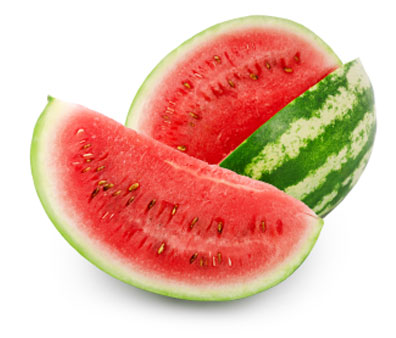
Written By: Sofia Layarda, MPH
Title: Master of Public Health
Alumni: University of California, Berkeley
Last Updated on:

Summer is finally in full swing and what better way to celebrate than featuring the staple fruit for hot weather: watermelon. Belonging to the same family of plants as cantaloupe and squash, watermelons are in peak season during the hot summer months, when they are sweet, juicy, and flavorful. While the most common variety of watermelon we see has pink flesh, you can also get pale yellow or bright yellow varieties. The fruit can be perfectly round or oval-shaped, and there are even square-shaped melons from Zentsuji, Japan where farmers grow them in glass cases to achieve the desired shape. Domestically, the largest producers of watermelon are the states of California, Arizona, Florida, Georgia, and Texas.
Table of Contents

In the world of phytonutrients, watermelon wins hands-down. The juicy, watery flesh contains many beneficial antioxidants such as lycopene (the same kind found in tomatoes), which is strongly protective against cancers. It is also a good source of Vitamins C and A, both well-known antioxidants in their own right. Interestingly, a 2006 study in the Journal of Agricultural and Food Chemistry found that watermelon that have been stored for two weeks have higher levels of lycopene and beta-carotene than freshly harvested fruit, which supports the suggestion to consume fruits when they are at their ripest. The often-overlooked part of the watermelon, their seeds, have actually been found to be high in protein and beneficial unsaturated fats. In fact, a 2011 study of Iranian patients with dyslipidemia found that daily intake of powdered watermelon seeds had a favorable effect on blood cholesterol after six weeks.
To choose a good watermelon, look for a whole fruit that is heavy for its size with no bruising or soft spots. The rind should be smooth and one end of the melon should have a distinctly different color from the rest of the rind: this is the spot where the fruit was resting on the ground during ripening. If the fruit lacks this marking, it may have been harvested prematurely and therefore will not be at its optimum flavor.
Alumni: University of California, Berkeley – Sofia believes in bringing back fun and pleasure into everyday eating. She loves cooking, and is constantly experimenting with ingredients, creating recipes and trying them out on family and friends. Her latest interest lies in finding realistic and practical ways of environmentally-friendly food/eating habits.
antioxidant, fruits, grocery aisle, healthy every month, lycopene, watermelon